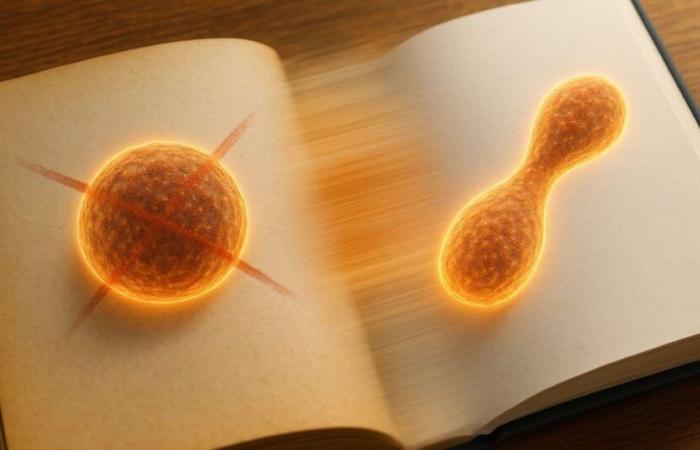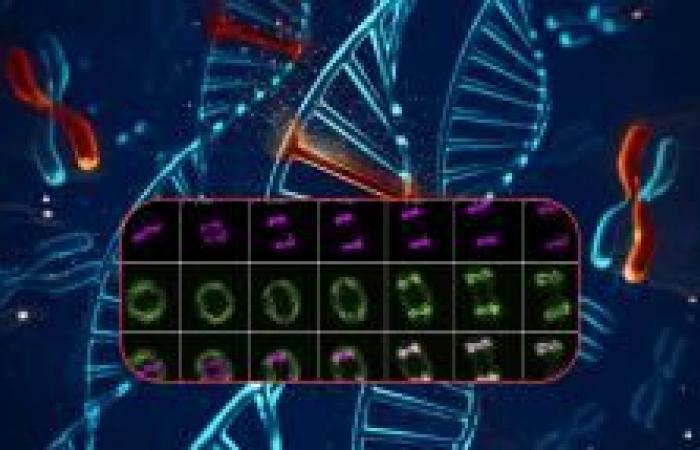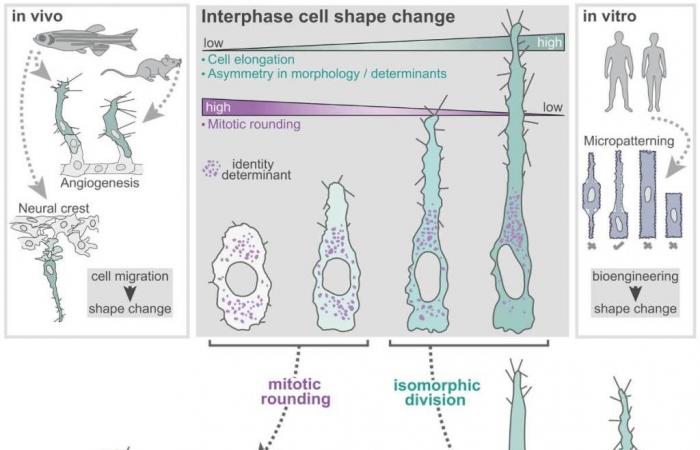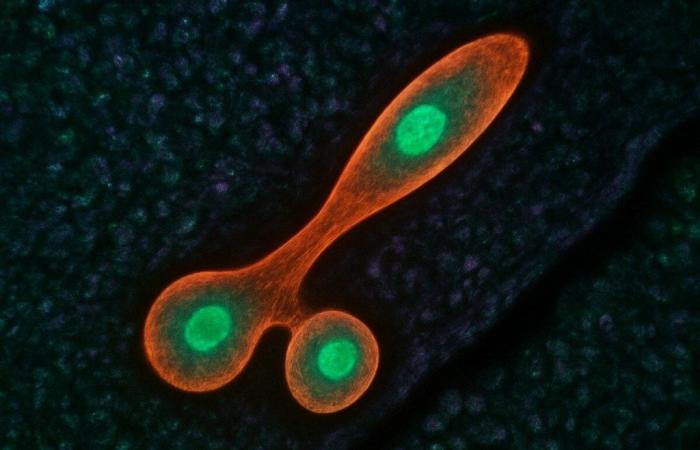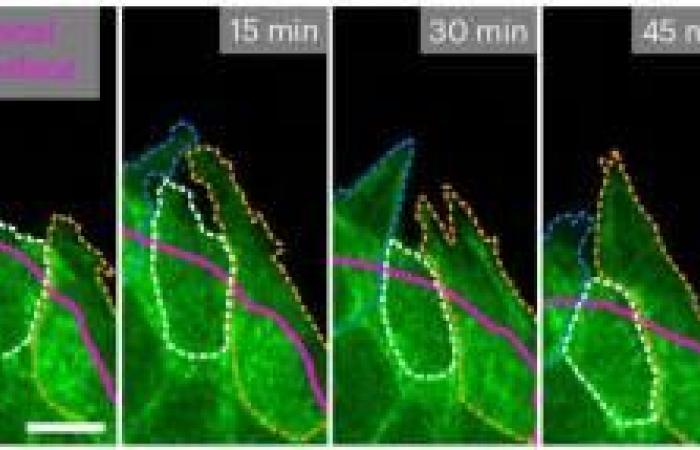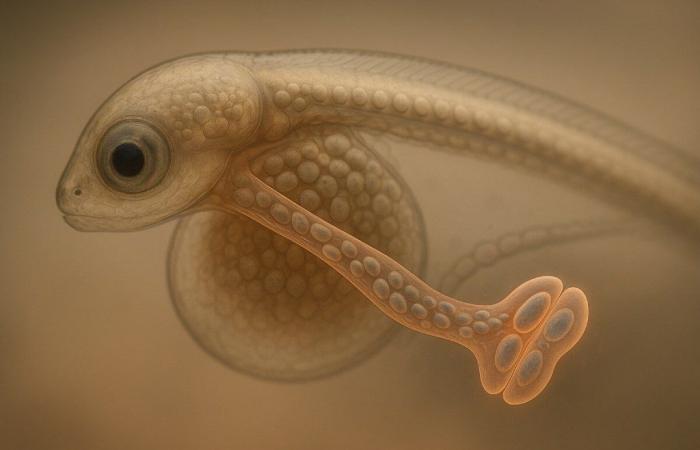Created: 3.05.2025 | 08:33 Updated: 3.05.2025 | 08:33
For years, in any classroom of sciences of the world, the process of cell division with a simple drawing has been explained: A round cell is divided into two identical parts. Two perfectly symmetrical spheres, equal in form and depending. If you paid attention in class, you probably remember. But What if that scheme, as entrenched as familiar, was bad in many cases? What if the cells do not always round? What if your daughters were not exactly the same?
A group of scientists from the University of Mercanters has just published a study in the magazine Science That could change that drawing forever. The work demonstrates that the shape of a cell before dividing largely determines how it will be divided and what type of daughter cells will generate. Far from the symmetry taught as a standard, many cells They maintain elongated or irregular shapes and are divided asymmetricallygiving rise to cells with different functions and structures. This finding directly challenges what we have been repeating in school books for more than a century.
When the cell is not rounded
One of the central points of the study is that The cell “round” prior to the division is not universal. Until now, it was thought that animal cells should adopt a spherical shape just before dividing to ensure a balanced distribution of cell content. However, this work demonstrates that this roundness is just one of the possibilities. The cells in the moments of the division, as the researchers demonstrate, are often not rounded in spherical shapes.
To this new way of dividing it have been called Isomorphic division. In it, the cell does not radically modify its previous shape, but maintains it, and with it it also retains functional asymmetries that will influence daughter cells. This has a direct involvement: not all cell divisions generate identical cells, and that is not exclusive to stem cells, as believed so far.
The finding is especially relevant because connects the previous morphology of the cell with the result of the divisionsomething that had not been shown so far. The team studied this phenomenon in several contexts, including zebra fish embryos, where cells migrate and lengthen during tissue formation.

The form matters more than we thought
Through morphometric analysis techniques and real -time observation, researchers found that The shape of a cell just before entering mythosis conditions the type of division that will perform. Stereotyped changes in premitting cell morphology act as preserved instructional signs that adjust the mode, symmetry and the result of mitosis.
This type of division is not a rarity of laboratory. It has been observed in real development processes, as in the formation of blood vessels, where a cell called “Tip Cell”, which leads migration, It is not rounded before dividing and generates two cells with different functions. This ability to generate cell diversity from a single division deeply changes our conception about how tissues and organs are formed.
The implications of the finding are wide. In the words of researcher Shane Herbert, The shape of the cell before dividing can determine whether your daughters are symmetrical or asymmetric, both in size and in function. This opens new questions about the control of embryonic development, tissue regeneration and even the evolution of certain specialized cell types.

A finding with medical applications
In addition to rewriting what is taught in classrooms, this discovery could have an important impact on the field of regenerative medicine and cancer research. If the previous shape of the cell can influence the fate of their daughtersthen manipulating that form could become a tool to guide cell differentiation.
In the oncological context, it has been proposed that this type of asymmetric divisions is not only a natural diversification mechanism, but also a path by which tumor cells can generate different populationssome more invasive or resistant. In other words, Asymmetry could be at the service of tumor progression. The study indicates that these “non-control” divisions could Generate cellular behaviors that promote metastasis.
In parallel, in tissue engineering laboratories and regenerative medicine, this finding suggests that Giving artificial shape to cells could help direct their functional destination. It would not be necessary to modify its genetic material, but simply alter its geometry before they divide. It is a subtle approach, but with enormous potential to produce concrete cell types in culture.
How the geometric revolution was studied
The research team combined observation in living organisms with cell bioengineering tools. On the one hand, they used Transparent Hecting Fish Embryowhich allowed them to film in real time how cells were divided into the developing body. Thus, they could observe how The elongated cells of the front of the blood vessels were divided without rounding, maintaining a different functional identity for each daughter cell.
On the other hand, they used a technique known as micropatterningwhich allows precisely to control the form that cells adopt in culture. Through the use of lasers and specially treated surfaces, they managed to force cells to adopt elongated, circular or other specific geometries. The researcher Georgia Hulmes explained: “The micropatrony allows us to generate microscopic patches of protein specifically to which the cells can adhere. The cells then adopt the shape of the patch, which allows us to change their shape and verify how this affects the posterior cell division.”
This experimental approach confirmed that The geometry imposed before mitosis directly influences the symmetry and division resultboth in living organisms and in human cells in the laboratory. In isomorphic divisions, they were also observed Asymmetric distributions of key organellesas Rab4 recycling endosomes, which transport determinants of cell destiny.

Redrawing basic biology
This work is not just a technical advance or an experimental curiosity. Represents A review of one of the most basic principles of cell biology: The way of dividing a cell. That this occurs outside of exceptional contexts – like stem cells – and that it is based on something as physical as the geometry of the cytoplasm, Altera our vision of cell development.
Therefore, the authors affirm that isomorphic divisions constitute a “Geometric revolution against symmetry”And although it may seem a detail, it is one that changes the meaning of how life is built from a single cell. The practical consequences are still to be explored, but the first step is clear: It is necessary to update what we teach, what we investigate and what we take for granted about mitosis.
References
- Holly E. Lovegrove, Georgia Hulmes, Helen O. Taylor, Rebecca Corrigan, Ellie M. Goddard, Shane P. Herbert. Interphase cell morphology defines the mode, symmetry, and outcome of mitosis. Science. 2 May 2025. DOI: 10.1126/science.adu9628.

